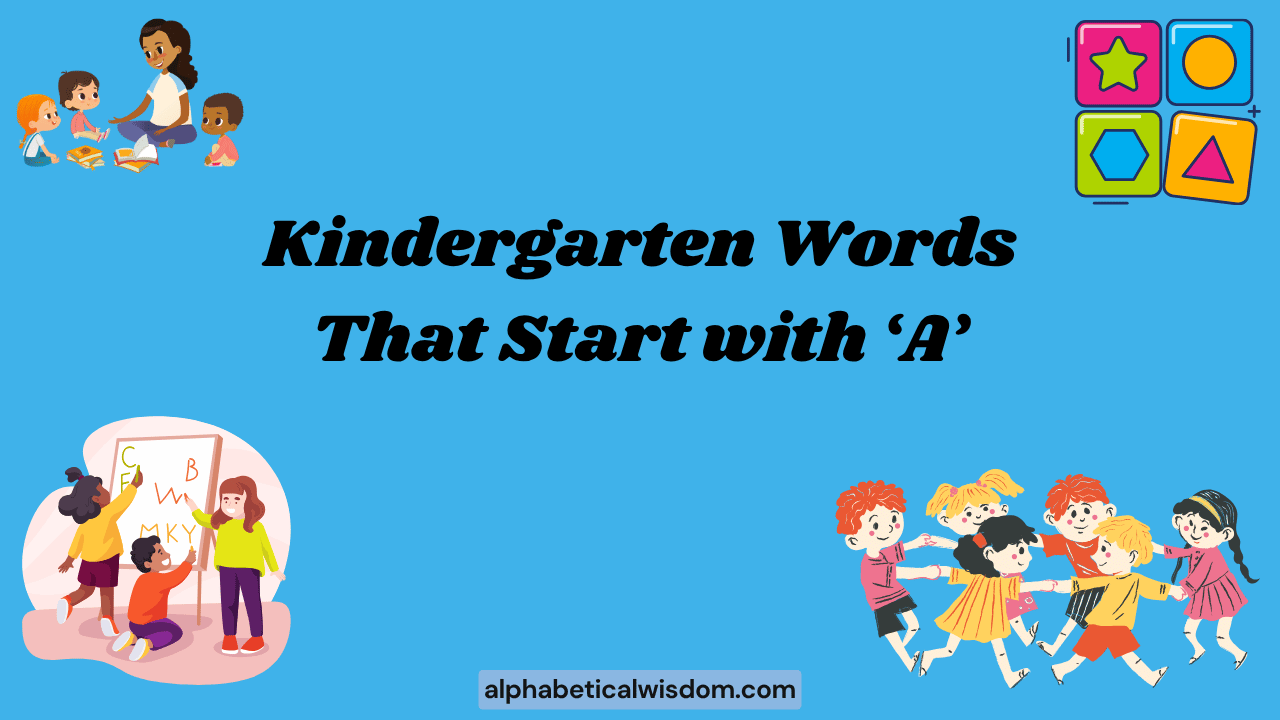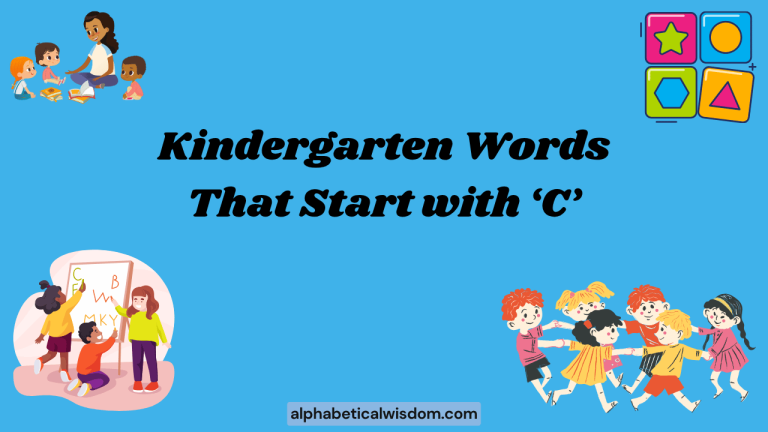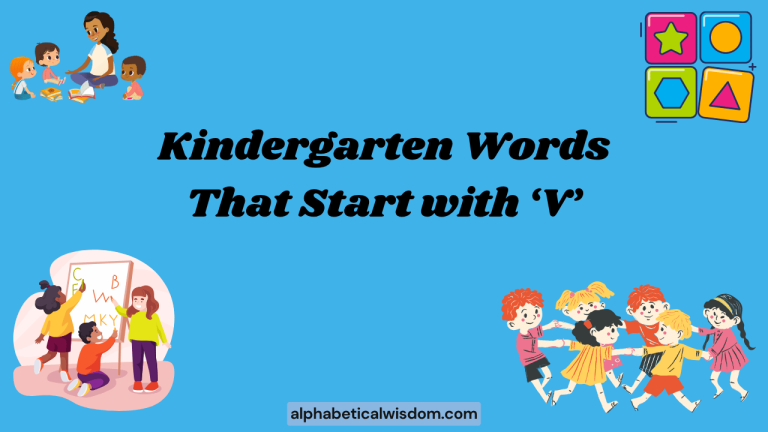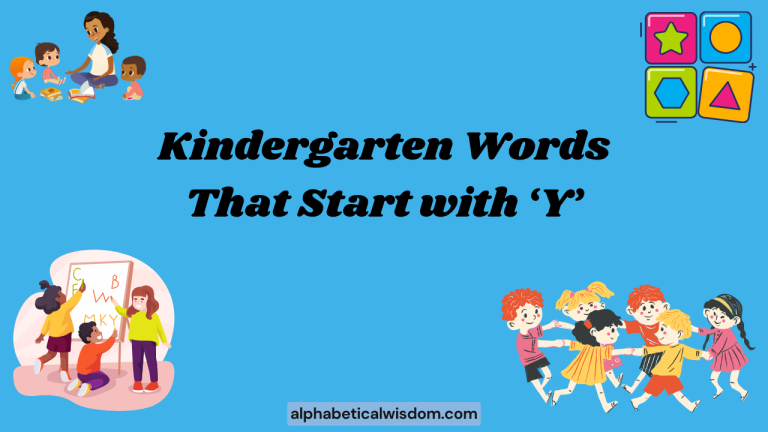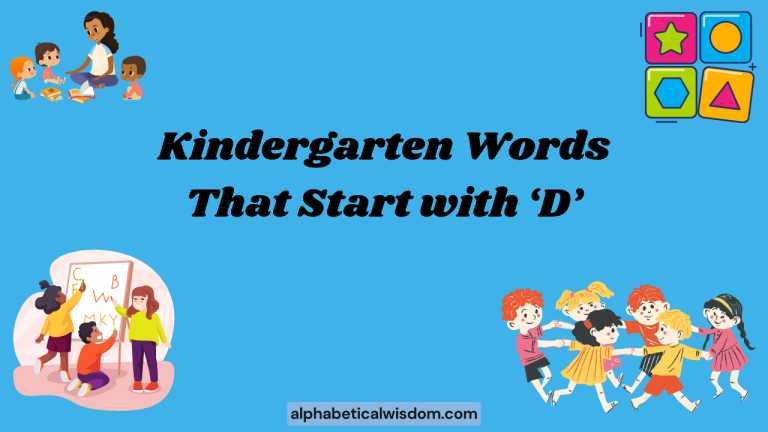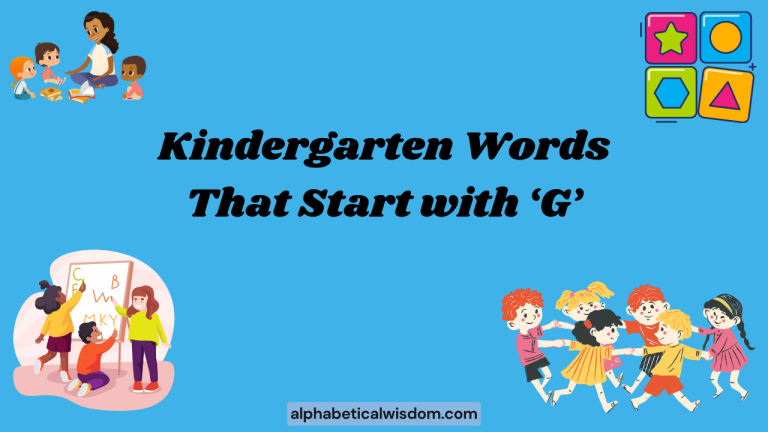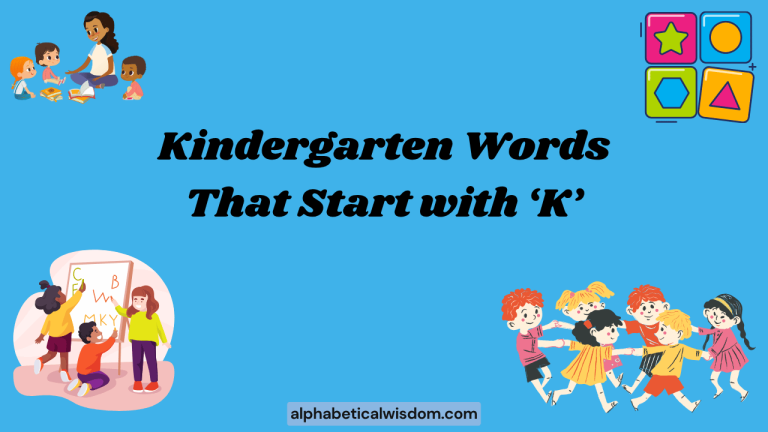Kindergarten Words That Start With A: A Comprehensive Guide
Understanding words that begin with the letter “A” is a foundational step in a child’s literacy journey. For kindergarteners, mastering these words helps build vocabulary, improves reading skills, and enhances overall language development.
This article provides a detailed exploration of common “A” words suitable for kindergarten, offering definitions, examples, and practical exercises to reinforce learning. Whether you’re a teacher, parent, or caregiver, this guide will equip you with the knowledge and tools to effectively support young learners in expanding their vocabulary and language proficiency.
By focusing on clear explanations and engaging activities, we aim to make learning fun and accessible for all kindergarten students.
Table of Contents
- Introduction
- Definition of Kindergarten Words Starting With A
- Structural Breakdown of ‘A’ Words
- Types and Categories of ‘A’ Words
- Examples of Kindergarten ‘A’ Words
- Usage Rules for ‘A’ Words
- Common Mistakes with ‘A’ Words
- Practice Exercises
- Advanced Topics for ‘A’ Words
- FAQ: Frequently Asked Questions
- Conclusion
Definition of Kindergarten Words Starting With A
Kindergarten words starting with the letter “A” are fundamental vocabulary terms designed to introduce young children to the English language. These words are typically simple, concrete nouns, verbs, and adjectives that relate to familiar objects, actions, and concepts.
The primary function of these words is to build a basic vocabulary foundation, enabling children to communicate effectively and comprehend simple texts. These words serve as building blocks for more complex language skills, such as reading, writing, and sentence construction.
They are carefully chosen to be phonetically straightforward and visually recognizable, aiding in early literacy development. The use of “A” words in kindergarten extends beyond vocabulary acquisition; it also fosters cognitive development, enhances memory skills, and promotes a love for learning.
In the context of early childhood education, “A” words are often introduced through various engaging methods, including picture cards, interactive games, and storytelling. These techniques help to make learning fun and memorable for young learners.
The words selected for kindergarten curricula are typically those that children will encounter frequently in their daily lives, ensuring relevance and practicality. Furthermore, the introduction of “A” words is often integrated with phonics instruction, helping children to understand the relationship between letters and sounds.
This multi-sensory approach to learning enhances retention and comprehension, setting the stage for future academic success.
Structural Breakdown of ‘A’ Words
The structural breakdown of words starting with “A” for kindergarteners involves understanding the basic phonetic elements and common spelling patterns. Many of these words follow simple consonant-vowel-consonant (CVC) or consonant-vowel (CV) structures.
For instance, words like “ant” (CVC) and “ape” (CVCe, where ‘e’ is silent) illustrate these patterns. Understanding these structures helps children decode and encode words more effectively.
The letter “A” itself can represent various sounds, such as the short ‘a’ sound in “apple” or the long ‘a’ sound in “apron”. Recognizing these different phonetic values is crucial for accurate pronunciation and spelling.
Furthermore, the position of “A” within a word can influence its sound, adding another layer of complexity to early literacy instruction. By breaking down words into their constituent sounds and letters, educators can help children develop a deeper understanding of the English language.
The morphology of “A” words, although basic at this stage, also plays a role. Some words may have simple suffixes added, such as “ants” (plural of “ant”), introducing the concept of pluralization.
Compound words, while less common, may also be introduced, like “airplane.” These structural elements provide early exposure to more complex word formations. Teachers often use visual aids and hands-on activities to demonstrate these patterns, reinforcing the connection between letters, sounds, and meanings.
This structured approach to word study builds a strong foundation for future vocabulary and reading comprehension skills. Moreover, understanding these structural elements empowers children to become confident and independent learners.
Types and Categories of ‘A’ Words
Kindergarten words that start with “A” can be categorized into several different types, based on their grammatical function and meaning. These categories include nouns, verbs, and adjectives, each playing a distinct role in sentence construction and communication.
Understanding these categories helps children grasp the different ways words can be used to describe, name, and express actions. Each category is essential for building a well-rounded vocabulary and developing effective language skills.
By exploring these different types, children gain a deeper appreciation for the versatility and richness of the English language.
Nouns
Nouns are words that name people, places, things, or ideas. Common “A” nouns for kindergarteners include “apple,” “ant,” “airplane,” and “animal.” These words represent concrete objects and beings that children can easily visualize and relate to, making them ideal for early vocabulary acquisition.
Nouns form the foundation of many sentences, providing the subjects and objects that actions are performed upon.
Verbs
Verbs are words that describe actions or states of being. “A” verbs commonly introduced in kindergarten include “ask,” “act,” and “add.” These words describe simple actions that children can understand and perform, making them relevant and engaging.
Verbs are essential for expressing what is happening in a sentence, adding dynamism and conveying meaning.
Adjectives
Adjectives are words that describe nouns, providing more information about their qualities or characteristics. Examples of “A” adjectives for kindergarteners are “angry,” “amazing,” and “adorable.” These words help children develop descriptive language skills and express their opinions and feelings.
Adjectives add detail and color to sentences, making them more interesting and informative.
Examples of Kindergarten ‘A’ Words
Below are some examples of kindergarten words that start with the letter ‘A’, categorized into Animals, Actions, Adjectives, and Objects. Each table provides a variety of words suitable for young learners, along with illustrative sentences.
These examples are designed to help children understand the meaning and usage of each word in context, reinforcing their vocabulary and language skills.
Animals
This table provides examples of animals whose names start with the letter “A”. Understanding animal names is a fun way for children to expand their vocabulary and learn about the world around them.
The sentences provided illustrate how these animal names can be used in simple, descriptive contexts.
| Word | Example Sentence |
|---|---|
| Ant | The ant crawled on the ground. |
| Ape | The ape swung from the tree. |
| Albatross | The albatross soared over the sea. |
| Alligator | The alligator swam in the swamp. |
| Armadillo | The armadillo rolled into a ball. |
| Angelfish | The angelfish is a colorful fish in the aquarium. |
| Anaconda | The anaconda is a large snake. |
| Arctic Fox | The Arctic fox has a thick white coat. |
| African Elephant | The African elephant has big ears. |
| Antelope | The antelope ran across the savanna. |
| Aardvark | The aardvark eats ants with its long tongue. |
| Adder | The adder is a type of venomous snake. |
| Admiral Butterfly | The Admiral butterfly has beautiful red markings. |
| Auk | The auk is a seabird found in colder regions. |
| Axolotl | The axolotl is a type of salamander that stays in the water. |
| Asian Elephant | The Asian Elephant is smaller than the African Elephant. |
| Aphid | The aphid is a small insect that feeds on plants. |
| Ara | The Ara is another name for the macaw parrot. |
| Alpine Ibex | The Alpine Ibex lives in the mountains. |
| American Robin | The American Robin is a common bird in North America. |
| Avocet | The Avocet is a bird with a long, upturned bill. |
| Arowana | The Arowana is a freshwater fish. |
| Ape | The ape is swinging from the tree branch. |
| Aardwolf | The aardwolf is related to the hyena. |
| Alpaca | The alpaca has soft, woolly fur. |
Actions
This section focuses on action words (verbs) that start with the letter “A.” These words are crucial for describing activities and movements. The examples provided illustrate how these verbs can be used in simple sentences, helping children understand their meanings and usage in context.
| Word | Example Sentence |
|---|---|
| Ask | I will ask a question. |
| Act | We can act in a play. |
| Add | Let’s add the numbers together. |
| Answer | Please answer the question. |
| Arrive | They will arrive at school soon. |
| Agree | I agree with what you said. |
| Announce | The teacher will announce the winner. |
| Admire | I admire your hard work. |
| Assist | Can you assist me with this task? |
| Accept | I accept your apology. |
| Achieve | We can achieve our goals if we try. |
| Adjust | Please adjust the volume. |
| Advance | We can advance to the next level. |
| Advise | My parents advise me to study hard. |
| Afford | Can we afford to buy that toy? |
| Aim | We should aim for the highest score. |
| Alert | The alarm will alert us if there’s a fire. |
| Allow | My mom will allow me to play outside. |
| Amuse | The clown will amuse the children. |
| Analyze | Let’s analyze the data to find the answer. |
| Appeal | The colorful pictures appeal to young children. |
| Applaud | The audience will applaud after the performance. |
| Apply | Please apply the glue to the paper. |
| Appoint | The teacher will appoint a class monitor. |
| Appreciate | I appreciate your help. |
Adjectives
This table lists adjectives that begin with the letter “A.” Adjectives are descriptive words that add detail and color to language. The examples show how these adjectives can be used to describe nouns, enhancing children’s ability to express themselves and understand descriptions.
| Word | Example Sentence |
|---|---|
| Angry | The boy was angry because he lost his toy. |
| Amazing | The magic show was amazing. |
| Adorable | The puppy is so adorable. |
| Afraid | The kitten was afraid of the loud noise. |
| Alert | The dog is alert and watching. |
| Absent | She was absent from school today. |
| Accurate | His answer was accurate. |
| Active | The children are very active during playtime. |
| Actual | This is the actual size of the toy. |
| Adaptable | The chameleon is very adaptable to its surroundings. |
| Adequate | We have adequate supplies for the trip. |
| Adventurous | The children are adventurous explorers. |
| Affectionate | The cat is very affectionate. |
| Agile | The monkey is very agile in the trees. |
| Alarming | The loud noise was alarming. |
| Alright | Are you alright after the fall? |
| Ambitious | She is ambitious and wants to be a doctor. |
| Ancient | The pyramids are ancient structures. |
| Annoying | The buzzing sound is annoying. |
| Annual | This is the annual school picnic. |
| Apparent | It’s apparent that he’s tired. |
| Appropriate | This is appropriate behavior for school. |
| Approximate | The approximate cost is about ten dollars. |
| Artistic | She is very artistic and loves to draw. |
| Attentive | The students are attentive in class. |
Objects
This section presents examples of objects that start with the letter “A.” These nouns represent tangible items that children can easily identify and relate to. The example sentences illustrate how these words are used in context, helping children expand their vocabulary and understanding of the world around them.
| Word | Example Sentence |
|---|---|
| Apple | I like to eat a red apple. |
| Airplane | The airplane flies in the sky. |
| Apron | She wears an apron when she cooks. |
| Album | We have a photo album with family pictures. |
| Anchor | The ship dropped its anchor. |
| Arrow | The archer shot an arrow. |
| Axe | The lumberjack used an axe to chop wood. |
| Actor | The actor performed on stage. |
| Address | What is your home address? |
| Agenda | We have a busy agenda for the meeting. |
| Almond | I like to eat almond nuts. |
| Ambulance | The ambulance rushed to the hospital. |
| Amount | What is the total amount of money? |
| Angle | The triangle has three angles. |
| Ankle | I hurt my ankle while playing. |
| Answer | What is the answer to the question? |
| Apartment | We live in an apartment building. |
| Appetite | I have a big appetite for lunch. |
| Area | What is the area of the room? |
| Argument | They had an argument about the game. |
| Army | The army protects our country. |
| Article | I read an interesting article online. |
| Artist | The artist painted a beautiful picture. |
| Assembly | We have a school assembly every Monday. |
| Assignment | I have a homework assignment to complete. |
Usage Rules for ‘A’ Words
Understanding how to use words that start with “A” correctly involves following basic grammar rules. Nouns, verbs, and adjectives each have specific roles in sentence construction.
For example, when using nouns, it’s important to distinguish between singular and plural forms (e.g., “ant” vs. “ants”).
With verbs, understanding tense is crucial (e.g., “ask,” “asked,” “asking”). Adjectives must be placed correctly to modify nouns effectively (e.g., “an angry boy”).
Additionally, the articles “a” and “an” are used before nouns, with “an” preceding words that begin with a vowel sound (e.g., “an apple,” “a car”). Proper usage of these words enhances clarity and accuracy in communication.
Recognizing these rules helps children build confidence in their language skills and avoid common errors.
Another important aspect of usage is understanding context. The meaning of a word can change depending on how it’s used in a sentence.
For instance, the word “act” can be used as a verb (“to act in a play”) or as part of a noun phrase (“an act of kindness”). Encouraging children to pay attention to the surrounding words and the overall meaning of the sentence can help them grasp these nuances.
Furthermore, providing opportunities for children to practice using “A” words in different contexts can reinforce their understanding and improve their fluency. This practical application of grammar rules is essential for developing effective communication skills.
Common Mistakes with ‘A’ Words
One common mistake kindergarteners make is confusing the use of the articles “a” and “an.” It’s important to remember that “an” is used before words that begin with a vowel sound, not just a vowel letter. For example, it’s correct to say “an hour” because the “h” is silent, making the word start with a vowel sound.
Another frequent error is misusing the plural forms of nouns, such as saying “apple” instead of “apples” when referring to more than one apple. Additionally, children may struggle with verb tenses, using the incorrect form of a verb in a sentence.
For instance, saying “I ask yesterday” instead of “I asked yesterday.” Addressing these common mistakes through targeted instruction and practice can help children develop more accurate and fluent language skills.
Another common mistake stems from not fully understanding the meaning of a word. For example, a child might use “amazing” and “adorable” interchangeably, even though they have different connotations.
Similarly, children may struggle with using adjectives correctly to describe nouns, leading to sentences that don’t make sense or lack clarity. By providing clear definitions, examples, and opportunities for practice, educators can help children overcome these challenges and develop a deeper understanding of the meaning and usage of “A” words.
This focused approach to error correction is essential for building a strong foundation in language skills.
| Incorrect | Correct | Explanation |
|---|---|---|
| A apple | An apple | “Apple” starts with a vowel sound, so use “an.” |
| I see one ant and two ant | I see one ant and two ants | Use the plural form “ants” for more than one ant. |
| Yesterday I ask | Yesterday I asked | Use the past tense “asked” to describe an action in the past. |
| The boy is amazing | The boy is angry | Use the correct adjective to describe the boy’s emotion. |
| A hour | An hour | “Hour” starts with a vowel sound, so use “an” even though the letter ‘h’ is present. |
| I want a apple | I want an apple | “Apple” begins with a vowel sound; therefore, “an” should be used. |
| Two airplane | Two airplanes | Plural nouns require the addition of ‘s’ or ‘es’ in most cases. |
| She angry | She is angry | Requires the verb ‘is’ to create a complete sentence. |
Practice Exercises
To reinforce understanding of “A” words, here are several practice exercises designed for kindergarteners. These exercises cover different aspects of vocabulary and usage, providing opportunities for children to apply their knowledge in a fun and engaging way.
Each exercise includes a set of questions and answers, allowing for self-assessment and immediate feedback. These activities are designed to build confidence and fluency in using “A” words correctly.
Exercise 1: Fill in the Blanks
Fill in the blanks with the correct “A” word from the word bank. This exercise helps reinforce vocabulary and understanding of word meanings in context.
| Question | Answer |
|---|---|
| I want to eat ____ apple. | an |
| The ____ crawled on the picnic blanket. | ant |
| The ____ flew high in the sky. | airplane |
| She wore an ____ to protect her clothes. | apron |
| The baby is so ____. | adorable |
| He is ____ because he lost his toy. | angry |
| Can you ____ me a question? | ask |
| Let’s ____ the numbers together. | add |
| The show was ____. | amazing |
| The ____ lives in the jungle. | ape |
Exercise 2: Matching
Match the “A” word with its correct definition. This exercise helps reinforce vocabulary and understanding of word meanings.
| Word | Definition | Answer |
|---|---|---|
| Ant | A flying vehicle | C |
| Airplane | A fruit that grows on trees | E |
| Apple | A small insect | A |
| Angry | Feeling mad | D |
| Ape | A large primate | B |
Definitions:
- A small insect
- A large primate
- A flying vehicle
- Feeling mad
- A fruit that grows on trees
Exercise 3: Sentence Creation
Create a sentence using each “A” word. This exercise encourages creative thinking and reinforces understanding of word usage in context.
| Word | Example Sentence |
|---|---|
| Ant | The ant is carrying a crumb. |
| Airplane | The airplane is flying very high. |
| Apple | I like to eat a green apple. |
| Angry | The boy is angry because he can’t play. |
| Ask | I will ask my mom for a cookie. |
| Add | We can add two and two to get four. |
| Ape | The ape lives in the zoo. |
| Apron | My grandma wears an apron when she bakes. |
| Amazing | The fireworks show was amazing. |
| Adorable | The kitten is so adorable and fluffy. |
Advanced Topics for ‘A’ Words
For advanced learners, exploring the etymology of “A” words can provide deeper insights into the English language. Many words starting with “A” have roots in ancient Greek and Latin, reflecting the rich history of linguistic influences.
For example, the word “angel” comes from the Greek word “angelos,” meaning “messenger.” Understanding these origins can enhance vocabulary retention and comprehension. Additionally, exploring figurative language, such as idioms and metaphors that use “A” words, can further expand language skills.
For instance, the idiom “apple of one’s eye” means someone who is cherished. These advanced topics provide a more nuanced understanding of “A” words and their place in the broader context of the English language.
Another advanced area to explore is the use of “A” words in different dialects and registers. The pronunciation and usage of certain words may vary depending on regional accents and social contexts.
For example, the pronunciation of the word “ask” can differ significantly between different English-speaking regions. Understanding these variations can improve communication skills and cultural awareness.
Furthermore, analyzing how “A” words are used in literature and other forms of media can provide valuable insights into their stylistic and rhetorical functions. This advanced exploration encourages critical thinking and a deeper appreciation for the complexities of language.
FAQ: Frequently Asked Questions
- Why is it important for kindergarteners to learn words that start with “A”?Learning words that start with “A” is crucial for building a foundational vocabulary, improving reading skills, and enhancing overall language development in kindergarteners. These words are often simple and familiar, making them ideal for early literacy instruction.
- How can I make learning “A” words fun for my child?You can make learning “A” words fun by using picture cards, interactive games, and storytelling. Engaging activities that incorporate visual and auditory elements can help children remember words more effectively.
- What are some common mistakes children make with “A” words?Common mistakes include confusing the use of “a” and “an,” misusing plural forms of nouns, and using incorrect verb tenses. Targeted instruction and practice can help children avoid these errors.
- How do I teach my child the difference between “a” and “an”?Explain that “an” is used before words that start with a vowel sound, not just a vowel letter. Provide examples like “an apple” and “a car” to illustrate the rule.
- What are some good resources for finding kindergarten-appropriate “A” words?Many educational websites, workbooks, and children’s books provide lists of kindergarten-appropriate “A” words. Look for resources that focus on early literacy and vocabulary development.
- How can I help my child practice using “A” words in sentences?Encourage your child to create sentences using “A” words in different contexts. Provide prompts and examples to help them get started, and offer feedback and encouragement along the way.
- Are there any advanced concepts related to “A” words that I should be aware of?Advanced concepts include exploring the etymology of “A” words and understanding their usage in different dialects and registers. These topics can provide deeper insights into the English language.
- How often should I practice “A” words with my child?Regular practice is key to reinforcing learning. Aim to practice “A” words with your child for a few minutes each day, incorporating them into daily activities and conversations.
- What if my child is struggling to learn “A” words?Be patient and supportive. Break down the words into smaller parts, use visual aids, and provide plenty of opportunities for practice. If your child continues to struggle, consider seeking help from a teacher or educational specialist.
- How can I assess my child’s understanding of “A” words?Use practice exercises, quizzes, and informal assessments to gauge your child’s understanding of “A” words. Observe their ability to use the words correctly in sentences and conversations.
Conclusion
Mastering kindergarten words that start with the letter “A” is a significant milestone in a child’s early literacy development. This comprehensive guide has provided definitions, examples, and practical exercises to support young learners in expanding their vocabulary and language proficiency.
By understanding the structural elements, usage rules, and common mistakes associated with “A” words, educators and parents can effectively guide children on their path to becoming confident and fluent communicators. Remember that consistent practice, engaging activities, and a supportive learning environment are key to success.
Encourage children to explore the world of “A” words and discover the joy of language learning.
As children progress in their language journey, it’s important to continue building upon this foundation by introducing more complex vocabulary and grammar concepts. Encourage them to read widely, write creatively, and engage in meaningful conversations.
By fostering a love for language and providing ongoing support, you can empower children to achieve their full potential as lifelong learners. Keep reinforcing the concepts presented in this guide, and celebrate their achievements along the way.
With dedication and encouragement, children can confidently navigate the world of words and unlock the power of communication.
